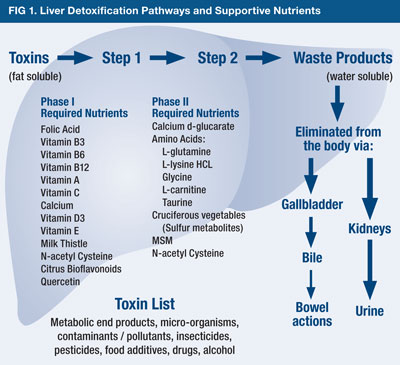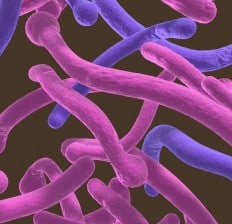- metabolic end products (artificial sweeteners)
- micro organisms (“negative flora” and parasites)
- contaminants/pollutants (petrochemicals, industrial chemicals)
- insecticides/pesticides (petrochemicals)
- food additives (chemicals, sodium compounds)
- drugs (chemicals)
- alcohol and street drugs
Phase One – Detoxification Pathway
Phase one detoxification is catalysed by enzymes referred to as the cytochrome P450 enzyme group or Mixed Function Oxidase enzymes MFO. The membrane system of the liver cells (hepatocytes) serve as the function platform of the P450. P450 synthesis is induced with exposure to toxins which provides a mechanism of protection. This pathway system metabolizes toxic chemical into a less harmful form.
This process occurs via oxidation, reduction, and hydrolysis, chemical reactions that produce free radicals are produced. If the level of free-radicals is excessive or chronically high, liver cell damage can outstrip the liver’s ability to regenerate its cells and damage function. Antioxidants reduce that damage. If antioxidant levels are low, from a poor diet, and toxin exposure is high, it is more difficult for liver to process and therefore excrete health-damaging substances. If those reactive molecules are ‘induced’, they may cause damage to cellular proteins, organelles, RNA, and DNA.
Substances that may encourage ‘induction’ of the P- 450 enzymes:
- Caffeine
- Alcohol
- Dioxin
- Saturated fats
- Organophosphorus pesticides
- Phthalates
- Sulfonamides and other pharmaceuticals
- Petrochemical fumes
- Barbiturates
- Artificial Sweeteners
P-450 enzyme systems are diverse, with specificity to inducement by particular drugs, toxins or metabolites or “substrates”. This characteristic has allowed the development of special tests to check the function of the liver’s various detoxification pathways.
Substrates of cytochrome P-450 enzymes.
- Theophylline
- caffeine
- phenacetin, acetaminophen
- lidocaine
- erythromycin, cyclosporin
- anti-fungals (ketoconazole)
- hormones: testosterone, estradiol, cortisone
- Beta-blockers: alprenolol, bopindolol, carvedilol, metoprolol, propranolol
- Anti-Depressants: amitriptyline, clomipramine, desipramine, nortriptyline, imipramine
- Opioids: codeine, ethyl-morphine
- dextromethorphan
- 4-methoxyamphetamine
- Phenytoin
- ibuprofen, naproxen, oxicam drugs
- S-warfarin
- Diazepam
- hexobarbitone
- PPIs: omeprazole
- alcohol
- Muscle relaxants: chlorzoxazone
- Anesthetics: enflurane
Cofactors of P450 Phase 1 detoxification
NADH, riboflavin, niacin, magnesium, iron, and indoles from cruciferous vegetables all support the liver’s detox function.
Cytochrome P450 inhibitors:
Grapefruit
Grapefruit juice decreases the rate of elimination of drugs from the blood and has been found to substantially alter their clinical activity and toxicity. Eight ounces of grapefruit juice contains enough of the flavonoid naringenin to decrease cytochrome P450 activity by 30%.
Curcumin
Inhibits phase I while stimulating phase II. This effect can be very useful in preventing certain types of cancer. Curcumin has been found to inhibit carcinogens, such as benzopyrene (found in grilled meat) and inhibit the growth of cancer cells. Curcumin exerts its anti-carcinogenic activity by lowering the activation of carcinogens while increasing the detoxification of those that are activated. Most of the cancer-inducing chemicals in cigarette smoke are carcinogenic during the period between activation by phase I and final detoxification by phase II, so curcumin can help prevent the cancer-causing effects of tobacco.
Phase I detoxification and aging
The activity of phase I detoxification enzymes decreases with age. Blood flow through the liver also becomes more sluggish, slowing detoxification further. Lack of exercise, necessary for good circulation, combined with the poor nutrition impair detoxification capacity as well.
Phase Two – Detoxification Pathway
Is the conjugation pathway, whereby the liver cells add another molecule (eg. cysteine, glycine or a sulphur molecule) to a toxin. This process makes the toxin or drug water-soluble, so the body can excrete it via bile or urine.
Major Phase II pathways
- Glutathione
- Sulphate
- Glycine
- Glucuronide conjugations
Sulphur containing foods and amino acids stimulate phase II detoxification
For efficient phase two detoxification, the liver cells require sulphur-containing amino acids such as taurine and cysteine. The nutrients MSM, glycine, glutamine, choline and inositol are also required for efficient phase two detoxification.
Eggs and cruciferous vegetables, raw garlic, onions, leeks and shallots are all good sources of natural sulphur compounds to enhance phase two detoxification. Thus, certain foods are considered cleansing ‘herbs’.
The Phase II enzyme systems include both UDP-glucuronyl transferase (GT) and glutathione-S-transferase (GSH-T).
Glutathione-S-transferase is the most powerful internal antioxidant and liver protector. It can be depleted by large amounts of toxins/drugs passing through the liver and improper nutrition. Phase II reactions may occur directly on a metabolite or may follow Phase I.
Substrates of the glycine pathway
Salicylates, benzoates (food preservatives) and many other substances are detoxified primarily through glycination or detoxified via the glycine conjugation pathway. People with a “toxed” feeling or sluggish digestion may have environmental toxicity without sufficient amounts of glycine to excrete them efficiently.
Substrates of the sulphation pathways
Neurotransmitters, steroid hormones, certain drugs such as Acetaminophen (also known as paracetamol) and many xenobiotic and phenolic compounds.
Substrates of glucuronidation
Polycyclic aromatic hydrocarbons, steroid hormones, some nitrosamines, heterocyclic amines, some fungal toxins, and aromatic amines. Spent hormones, such as estrogens and thyroid hormone are also excreted through this pathway.

Toxic Overload of Excess Body Burden
If the phase one and two detoxification pathways become overloaded, a build up of toxins occurs in the body. Many of these toxins are fat soluble and incorporate into fatty tissues where they may stay for years, if not for a lifetime. The brain and the endocrine glands are fatty organs, and are common sites for fat-soluble toxins to accumulate. This may result in symptoms of brain dysfunction and hormonal imbalances (infertility, breast pain, menstrual problems, adrenal gland fatigue, and early menopause). Petrochemicals contribute to this body burden and are carcinogenic, and have been implicated in the rising incidence of certain cancers.
Herbs that Improve Phase 1 and 2 Detoxification
Bitter herbs are foundational to herbal medicine. A range of physiological responses occur following stimulation of the bitter receptors of the tongue. The bitter taste stimulates the specific bitter taste buds at the back of the tongue to stimulate the parasympathetic nervous system to trigger a number of digestive reflexes.
Categories of Bitter Digestive Herbs
Sialogogues – stimulate saliva to digest carbohydrates.
Orexogenics – stimulate hydrochloric acid to digest protein.
Chologogues – Stimulate bile flow to digest fats and assist the liver in its detoxifying capacity.
The stimulation of the flow of digestive juices from the exocrine glands of mouth, stomach, pancreas, duodenum and liver, aid in digestion, absorption and assimilation of foods and nutrients. There is also a very mild stimulation of endocrine activities, especially insulin and glucagon secretion in the pancreas and can therefore be used to treat of non-insulin dependent diabetes.

